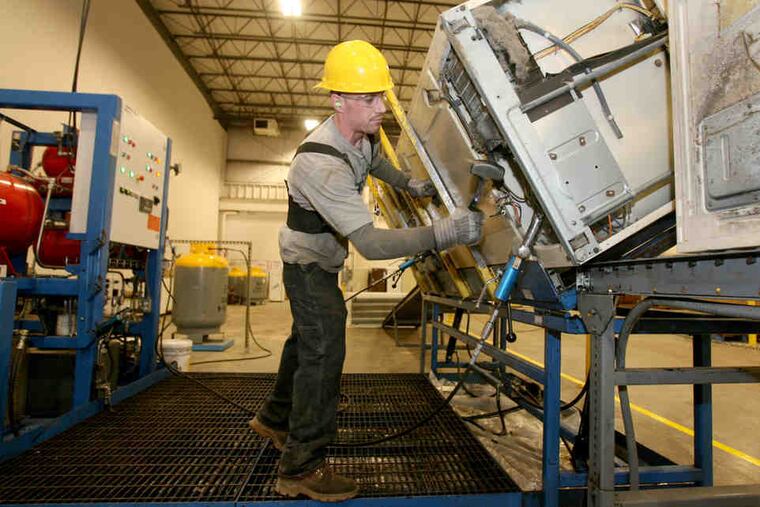GreenSpace: Cold war on the inefficient old fridge
The eco-culprits were lined up crookedly, like a ragtag group of reluctant soldiers. Their out-of-date colors hinted at their crimes:

The eco-culprits were lined up crookedly, like a ragtag group of reluctant soldiers.
Their out-of-date colors hinted at their crimes:
Avocado green.
Harvest gold.
Coppertone brown.
They were old refrigerators. Even ancient, some might say. I had harvest gold appliances in the '70s.
Unlike other older units, the problem isn't that these geriatric fridges break.
The problem is, they still work.
When many people get snazzy newbies, they still hang onto the oldsters, which often go into the basement with the best of intentions - keeping beer cold and helping with parties - but also the worst of consequences.
The older refrigerators are horribly inefficient, some using four times the electricity of newer models to do the same amount of cooling.
The one rusting away in your basement is also sucking $150 to $200 a year out of your pocketbook.
Older fridges are also problematic for utilities. They're trying to reduce electric usage as a way to avoid building new plants.
Today, utilities are so intent on prying these old fridges out of our homes that they'll pay us to let them do it.
Peco and PPL both offer $35 per fridge and will send out a truck to pick it up.
The units wind up in Hatfield at a facility owned by Jaco Environmental, based outside Seattle.
Here, starting from the motley lineup, they get sliced, diced, sucked dry of refrigerant, and otherwise dismantled and "demanufactured," the parts recycled.
Left in basements or carted off to landfills, "refrigerators are environmental time bombs," says Michael Dunham, Jaco's director of energy and environment.
Yet who knew the resources in a single fridge: 150 pounds of metal, 25 pounds of plastic, 3 pounds of glass.
Jaco sends the steel off to become the rebar that's often used in highways. "So you might some day be driving over your old refrigerator," Dunham is fond of saying.
The plastics are turned into electronics, such as your cell phone. So, yes, you might one day be talking on your old refrigerator.
The glass is tempered, so it can't be made into bottles. But it winds up as the sparkly stuff in countertops and some cements. It's also used as an aerator in potting soil.
The aluminum often becomes cans, winding up back in a different refrigerator.
The refrigerant - several kinds are all potent greenhouse gases - is destroyed.
The mercury found in some old thermostats gets cleaned and reused. Ditto the oil.
Two components that can't be recycled, the door foam and gasket, wind up in landfills after all, but only after being shredded so they can be used as aerating fluff.
One last thing: The insulating foam gets sent to a waste-to-energy facility in Massachusetts, where it is burned to make electricity. The 10 pounds per fridge produces about 15 kilowatt-hours.
The Hatfield facility employs 30 people, and has recycled 50,000 units in its first year. The average age: 22 years. Retiring these units saved 85,000 megawatts, Jaco said, enough to power 7,000 homes for a year.
(I'm not sure if that's counting the two 1940s vintage units that workers use to store their tools in.)
For Peco customers alone, getting rid of 15,662 old energy guzzlers saved 27,000 megawatt-hours. That is the equivalent of planting 30,000 trees or not driving more than 30 million miles, said spokeswoman Cathy Engel.
New Jersey has a similar program, run by the Board of Public Utilities. It bumps the homeowner payment to $50 per refrigerator or freezer.
It began in July 2009, and so far trucks have collected 27,000 refrigerators and recycled them at a Jaco facility in New Brunswick.
Nationwide, there were about 50 similar programs last year, according to an estimate by the Consortium for Energy Efficiency, a utility group.
I just wish our utilities had adopted this catchy slogan from a Utah operator: "See ya later, refrigerator."
Jaco, which has one competitor, got into the business about a decade ago, when California was having rolling blackouts and electric officials were frantically searching for unnecessary energy hogs. They fingered second refrigerators as one of the prime offenders.
In the last 21/2 years, Jaco has opened 12 more recycling facilities like the one in Hatfield. Last year, they demanufactured half a million units, Dunham says.
Sort of makes you wonder if they might run out.
Not likely, alas.
According to a 2009 refrigerator profile by the U.S. Department of Energy, 27 million pre-1993 refrigerators are still in use.
About 26 percent of households have a second refrigerator. The rate is growing by about 1 percent a year.
GreenSpace: How to Recycle an Old Fridge
Peco customers: Call 888-573-2672 or go to www.pecosmartideas.com.
PPL customers: Call 877-270-3522 or visit www.pplelectric.com/recycle.
In New Jersey: Call 877-270-3520 or visit www.NJCleanEnergy.com.
EndText